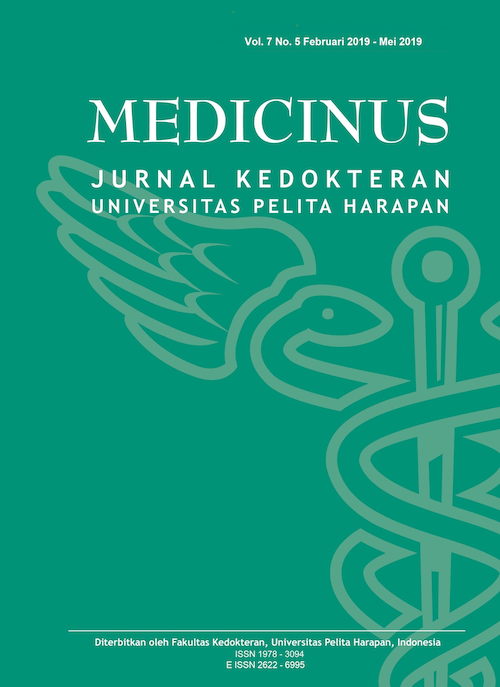Role of Span-75 in Determining Prognosis of Non-Thrombolysis Acute Ischemic Stroke Patients
DOI:
https://doi.org/10.19166/med.v7i7.2759Trefwoorden:
acute ischemic stroke, non-thrombolysis, prognosis, SPAN-75 indexSamenvatting
Introduction: The SPAN-75 index is a modification of the SPAN-100 index as a prognostic tool in acute ischemic stroke patients. Previous studies were using SPAN index in cases of ischemic stroke patients treated with rTPA and in cases of intracerebral hemorrhage.
Aim: To determine the role of the SPAN-75 index as a prognostic scoring in patients with acute ischemic stroke who did not get thrombolysis therapy.
Method: The subjects were acute ischemic stroke patients at Siloam Hospitals Lippo Village who were not treated with thrombolysis therapy and had no disability before stroke onset during January to April 2019. Subjects were classified into a positive and negative of SPAN-75 index group. Disability due to stroke was assessed with Modified Rankin Score (mRS) at the time of admission and discharged from the hospital. This prospective study was analyzed by the Kruskal-Wallis test.
Result: Forty subjects (average age of 57 years old) consisted of 31 negative and 9 positive of SPAN-75. Based on the Kruskal-Wallis test, the SPAN-75 index was positively associated with a more severe degree of stroke disability at the time of admission (p = 0.002), but not related to the change in the degree of disability when the patient was discharged from the hospital (p = 0.807). Age (p = 0.445) and gender (p = 0.578) had no significant relationship with the degree of disability of acute ischemic stroke.
Conclusion: The SPAN-75 index is related to the degree of disability of acute stroke patients at the time of admission.
Referenties
Donkor ES. Stroke in the 21st century: A Snapshot of the Burden, Epidemiology, and Quality of Life. Stroke Research and Treatment [Internet]. Hindawi Limited; 2018 Nov 27; 2018 : 1-10. https://doi.org/10.1155/2018/3238165
2. Ropper AH, Brown RJ. Adams and Victors Principles of Neurology. 10th ed. New York, NY: McGraw Hill Professional; 2014.
3. Konig IR, Ziegler A, Bluhmki E, Hacke W, Bath PMW, Sacco RL, et al. Predicting Long-Term Outcome After Acute Ischemic Stroke. Stroke[Internet]. Ovid Technologies (Wolters Kluwer Health); 2008 Jun; 39(6):1821-6. https://doi.org/10.1161/STROKEAHA.107.505867
4. Lyden P. Using the National Institutes of Health Scale. Stroke [Internet]. Ovid Technologies (Wolters Kluwer Health); 2017 Feb; 48(2): 513-9. https://doi.org/10.1161/STROKEAHA.116.015434
5. Saposnik G, Guzik AK, Reeves M, Ovbiagele B, Johnston SC. Stroke Prognostication using Age and NIH Stroke Scale: SPAN-100. Neurology [Internet]. 2012; 80(1): 21-8. https://doi.org/10.1212/WNL.0b013e31827b1ace
6. Abilleira S, Ribera A, Quesada H, Rubiera M, Castellanos M, Vargas M, et al. Applicability of the SPAN-100 index in a prospective and contemporary cohort of patients treated with intravenous rtPA in Catalonia. Neurologia (English Edition) [Internet]. Elsevier BV; 2016 Nov; 31(9):592-8. https://doi.org/10.1016/j.nrleng.2014.10.014
7. Mobius C, Blinzler C, Schwab S, Kohrmann M, Breuer L. Re-evaluation of the stroke prognostication using age and NIH Stroke Scale index (SPAN-100 index) in IVT patients - the-SPAN 10065 index. BMC Neurology [Internet]. 2018 Aug 29; 18(1):129-135.
https://doi.org/10.1186/s12883-018-1126-0
8. Banks JL, Marotta CA. Outcomes Validity and Reliability of the Modified Rankin Scale: Implications for Stroke Clinical Trials. Stroke [Internet]. Ovid Technologies (Wolters Kluwer Health); 2007 Mar; 38(3):1091-6. https://doi.org/10.1161/01.STR.0000258355.23810.c6
9. Fabiana NL, Lee CF, Gan R, Venketasubramanian N, Wong KSL, Bousser M-G, et al. Using the Full Span of the SPAN-100 Index to Predict Functional Outcome in CHIMES Study. International Journal of Stroke [Internet]. SAGE Publications; 2015 Jan 19 ; 10(2): E21.
https://doi.org/10.1111/ijs.12405
10. Escabillas C, Jane A, Lara K, Navarro J. Modified SPAN-100 index in patients with intracerebral hemorrhage: Correlation and outcomes. Journal of Systems and Integrative Neuroscience [Internet]. Open Access Text Pvt, Ltd.; 2015; 1(2): 33-5.
https://doi.org/10.15761/JSIN.1000107
11. Li M, Wang-Qin RQ, Wang YL, Liu LB, Pan YS, Liao XL, et al. Symptomatic Intracerebral Hemorrhage after Intravenous Thrombolysis in Chinese Patients: Comparison of Prediction Models. J Stroke Cerebrovasc. Dis [Internet]. 2015 Jun; 24(6):1235-43. https://doi.org/10.1016/j.jstrokecerebrovasdis.2015.01.026
12. Rabinstein A. Rundek T. Prediction of outcome after ischemic stroke: The value of clinical score. Neurology[Internet]. Ovid Technologies (Wolters Kluwer Health); 2012 Nov 21; 80(1):15-6. https://doi.org/10.1212/WNL.0b013e31827b1b5c
13. Nedeltchev K, der Maur TA, Georgiadis D, Arnold M, Caso V, Mattle HP, et al. Ischaemic stroke in young adults: predictors of outcome and recurrence. J Neurol Neurosurg Psychiatry[Internet]. BMJ; 2005 Feb 1; 76(2): 191-5.
https://doi.org/10.1136/jnnp.2004.040543
14. Ganesh A, Luengo-Fernandez R, Wharton RM, Rothwell PM. Ordinal vs dichotomous analyses of modified Rankin Scale, 5 year outcome, and cost of stroke. Neurology [Internet]. Ovid Technologies (Wolters Kluwer Health); 2018 Oct 19; 91(21):e1951-e1960.
https://doi.org/10.1212/WNL.0000000000006554
##submission.downloads##
Gepubliceerd
Citeerhulp
Nummer
Sectie
Licentie
Copyright (c) 2020 Anyeliria Sutanto, Astra Dea Simanungkalit, Evelyn Yunita, Anastasya Chandra, Aristo Pangestu, Pamela Tiffani

Dit werk wordt verdeeld onder een Naamsvermelding-GelijkDelen 4.0 Internationaal licentie.
Authors who publish with this journal agree to the following terms:
1) Authors retain copyright and grant the journal right of first publication with the work simultaneously licensed under a Creative Commons Attribution License (CC-BY-SA 4.0) that allows others to share the work with an acknowledgement of the work's authorship and initial publication in this journal.
2) Authors are able to enter into separate, additional contractual arrangements for the non-exclusive distribution of the journal's published version of the work (e.g., post it to an institutional repository or publish it in a book), with an acknowledgement of its initial publication in this journal.
3) Authors are permitted and encouraged to post their work online (e.g., in institutional repositories or on their website). The final published PDF should be used and bibliographic details that credit the publication in this journal should be included.





